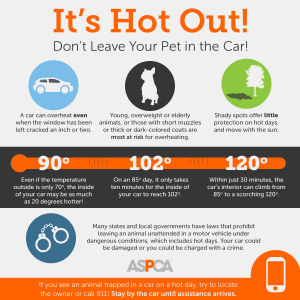Between natural and man-made hazards and hot and humid weather, keep your furry family members safe all summer. Below are tips from the American Society for the Prevention of Cruelty to Animals (ASPCA), the American Veterinary Medical Association (AVMA), American Humane and VetStreet.
1. Keep Them Cool
- Heatstroke is a major danger for pets when weather turns hot and humid.
- Never leave your pet in a car – temperatures can rise quickly – even if the vehicle is parked in the shade with the windows slightly open. If the outside temperature is relatively mild—for example, 70 degrees—in 30 minutes, the inside vehicle temp can reach 104 degrees. The chart on the AVMA website shows what to know.
- Make sure your pet has plenty of water to drink and shade to protect them from the sun. If they are outdoors, be aware that hot asphalt can burn paws! Even if they are indoors, they should have access to a space that is comfortable for them.
WHN Expert TIP — 10 Heat Stress Signs: Know the 10 signs of heat stress and seek emergency veterinary care if your pet shows them: anxiousness, excessive panting, difficulty breathing, restlessness, increased heart and respiratory rate, excessive drooling, unsteadiness, mild weakness, abnormal gum and tongue color (dark or bright red), collapse. Other symptoms can include seizures, bloody diarrhea, and vomit along with an elevated body temperature of over 104 degrees.
WHN TIP — A/C Failure Risk: If your pet is confined to a room or crate while you’re away from home, have you thought about what will happen if your air conditioning fails? Consider using a smart thermostat that will alert you if the indoor temp reaches a pre-set level. Safety.com has reviews of smart thermostats here.
2. Protect from Poisons
- The ASPCA notes that pets can have allergic reactions not only to food but also to dust, plant pollens, and insect bites. Reactions can range from itching to life-threatening anaphylactic shock.
- Want a weed-free yard? The AVMA warns that lawn fertilizer and insecticides can be hazardous to your pet. Follow all safety instructions on lawn and garden products, including how long pets should be kept off the treated area. Use a lawn care service? Let them know you have a pet and ask about any safety rules.
- Outdoor plants like daisies, dahlias and chrysanthemums may be lovely but they are also toxic, says VetStreet. Keep pets and plants nibbling distance apart, and if you think Fluffy or Fido has taken a bite, call your vet or the ASPCA’s Animal Poison Control Center at (888) 426-4435 for advice. (The ASPCA has a list of toxic and non-toxic indoor and outdoor plants and flowers here.)
3. Secure the Screens
- Pets love to look out the window to watch what’s happening outdoors. And if the window is open, they can also enjoy the breeze. Though secure the screen so no one falls out the window. This is what the ASPCA calls “High-Rise Syndrome.” If you aren’t sure if the screen can withstand a good push from your pet, make the room off-limits.
- Screen doors can pose another type of hazard since bigger pets could possibly push out the screen and escape. Either keep the door closed or install a barrier that is pet-proof.
4. Beat the Burn
- Both asphalt and hot sand can burn paw pads. As for the coat, long-haired pets can get a trim (for cats, just brush them more often than usual), though the ASPCA says to skip the shave for dogs, since the layers protect it from overheating and sunburn.
- VetStreet recommends fragrance-free pet sunscreen or a sunblock with broad spectrum UVA and UVB barriers for vulnerable areas like nose, ear tips and belly. Not sure which to use or where to put it? Ask your vet for advice.
5. Watch the Water
- Whether it’s the backyard kiddy pool or a boating excursion on the ocean, pets are at risk for drowning. The ASPCA says to gradually introduce your pets to water and if they will be on a boat, equip them with flotation devices.
- VetStreet has a list of pet water safety products here. (Consider using these even if your pet is just on the beach or poolside—better safe than sorry!)
- Taking Fido along for a boat ride? Boat USA has tips for keeping your pet safe on the seas, along with a video on how to make sure the life jacket you buy for your pet is the right size.
For More Information
Check out the following posts for more pet-related safety tips.
Photo Credit: Unsplash

